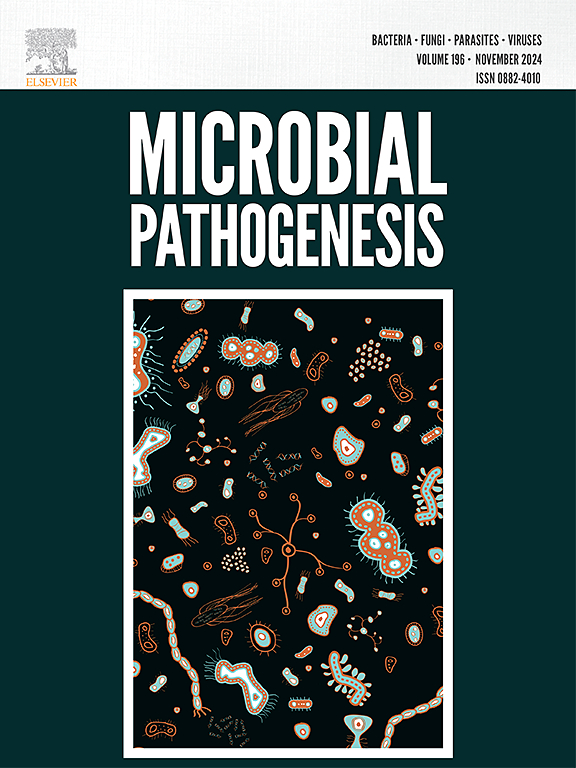实验感染爱德华氏菌后,鲤鱼表皮和黏液粘度的变化。
IF 3.5
3区 医学
Q3 IMMUNOLOGY
引用次数: 0
摘要
本研究研究了一种细菌病原体,迟缓爱德华菌对印度主要鲤鱼Cirrhinus mrigala表皮和粘液粘度的影响。将鱼分为三组:对照组(未处理)、媒介对照组(第0天注射50 μl磷酸盐缓冲盐水(PBS))和感染组(第0天注射50 μl含有2.2 × 106 CFU/鱼的亚致死剂量的PBS,即96小时LD50的10%)。在感染后2d、4d、6d和8d观察细胞表面结构、组织学、增殖细胞核抗原(PCNA)和诱导型一氧化氮合酶(iNOS)表达、乳酸脱氢酶(LDH)和琥珀酸脱氢酶(SDH)的特异性活性变化。镜下检查显示表皮上皮细胞肥大,伴有微脊断裂和紊乱,以及脱落。粘液杯状细胞(MGCs)密度在感染早期显著增加。俱乐部细胞表现出退行性变化,包括空泡化、与邻近细胞的间隔融合以及同时将其内容物排出到表面。检测到inos阳性细胞显著增加。PCNA在感染鱼体内的表达显著降低,表明细胞增殖能力降低。皮肤粘液表现出非牛顿行为,在低剪切速率下具有较高的粘度,在受感染的鱼体内显著降低,表明在应激下变薄和脱落。迟发E.感染也引起LDH活性显著升高,SDH活性显著降低。本研究将深入了解宿主防御机制,并为建立早期预警系统以控制养殖鱼类疾病爆发提供知识基础。本文章由计算机程序翻译,如有差异,请以英文原文为准。
Alterations in the epidermis and mucus viscosity of the carp, Cirrhinus mrigala, experimentally infected with Edwardsiella tarda
This study investigated effects of a bacterial pathogen, Edwardsiella tarda on the epidermis and mucus viscosity of an Indian major carp, Cirrhinus mrigala. The fish were divided into three groups: a control group (no treatment), a vehicle control group (fish injected with 50 μl of phosphate-buffered saline (PBS) at day 0), and an infected group (fish injected with 50 μl of PBS containing a sublethal dose of 2.2 × 106 CFU/fish, which is 10 % of the 96-h LD50, at day 0). Alterations in the surface architecture, histology, proliferating cell nuclear antigen (PCNA) and inducible nitric oxide synthase (iNOS) expression, specific activity of lactate dehydrogenase (LDH) and succinate dehydrogenase (SDH) were studied at 2d, 4d, 6d and 8d post-infection. Microscopic examination showed hypertrophy of the epidermal epithelial cells, accompanied by disrupted and disorganized microridges, as well as exfoliation. Mucous goblet cells (MGCs) density increased significantly at an early stage of infection. Club cells exhibited degenerative changes, including vacuolization, confluence with neighbouring cells at intervals and simultaneous discharge of their contents onto the surface. A significant increase in iNOS-positive cells was detected. PCNA expression was significantly lower in infected fish, indicating reduced cell proliferation. Cutaneous mucus showed non-Newtonian behavior, with higher viscosity at low shear rates which decreased significantly in infected fish, indicating thinning and shedding under stress. E. tarda infection also caused a significant increase in LDH activity and a decrease in SDH activity. This study will provide deep insight into the host defence mechanisms and serve as a knowledge base for the establishment of early warning systems to control disease outbreaks in farmed fish.
求助全文
通过发布文献求助,成功后即可免费获取论文全文。
去求助
来源期刊

Microbial pathogenesis
医学-免疫学
CiteScore
7.40
自引率
2.60%
发文量
472
审稿时长
56 days
期刊介绍:
Microbial Pathogenesis publishes original contributions and reviews about the molecular and cellular mechanisms of infectious diseases. It covers microbiology, host-pathogen interaction and immunology related to infectious agents, including bacteria, fungi, viruses and protozoa. It also accepts papers in the field of clinical microbiology, with the exception of case reports.
Research Areas Include:
-Pathogenesis
-Virulence factors
-Host susceptibility or resistance
-Immune mechanisms
-Identification, cloning and sequencing of relevant genes
-Genetic studies
-Viruses, prokaryotic organisms and protozoa
-Microbiota
-Systems biology related to infectious diseases
-Targets for vaccine design (pre-clinical studies)
 求助内容:
求助内容: 应助结果提醒方式:
应助结果提醒方式:


